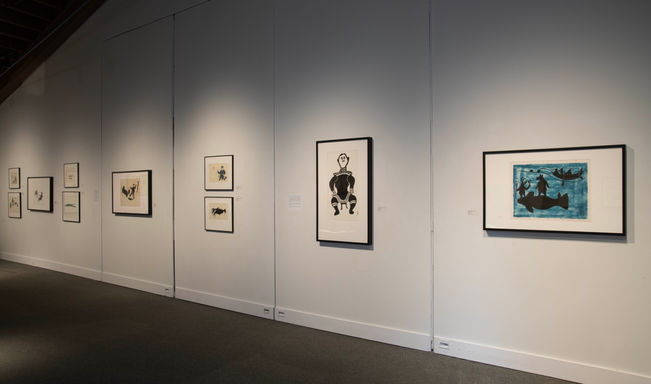
From the Vault: The Inuit Collection
MARCH 31 – JUNE 11, 2023
Since our founding in 1968, the Inuit collection has evolved with thanks to the generosity of primary donors Doreen Hutchinson on behalf of the Bessie Fitzgerald estate, Catharine Robb Whyte, and Hubert E. Green Jr. The pristine condition of the collection is in part due to the expertise of our staff but also from the advice of professional associations, in particular the Canadian Conservation Institute (CCI) in Ottawa. It is a Special Operating Agency within the Department of Canadian Heritage, that advances and promotes the conservation of heritage collections in Canada through its expertise in conser- vation science, treatment and preventive conservation. The CCI works with heritage institutions and professionals to ensure these heritage collections are preserved and accessible to Canadians now and in the future. Following is abbreviated text from “The Care of Inuit Carvings,” Canadian Conservation Institute (CCI) Notes 6/9 by Tom Stone.
For centuries, Inuit have been carving utilitarian stone cook pots and oil lamps and decorating their tools of wood, stone, bone, and ivory with artistic designs. In the late 19th and early 20th centuries, they began creating sculpture as a source of income. These early commercial carvings were sold or traded to European and American whalers, who began frequenting the arctic regions at that time. The early works were, usually, small carvings from walrus ivory, representing local animals and Inuit themselves, going about everyday life. Seals, caribou, polar bears, birds, and other animals important to Inuit’s survival were often represented. As well, they carved small ivory genre scenes of hunting from kayaks, driving dog teams, or flensing seals. Appropriately, these small items are usually referred to as “trade sculptures.”
Inuit carving as we know it today dates from the late 1940s and early 1950s, as a result of the enthusiasm of a young artist from Ontario, James Huston, and the Canadian Handicraft Guild’s “[Inuit] Project.” The Project was designed to encourage the development of handicrafts as an additional source of income in Inuit communities. With the cooperation of The Hudson’s Bay Company and some financial support from the Canadian government, the Project encouraged the development of a number of art-related handicrafts in several Arctic communities. The small stone and ivory carvings initially produced proved to be extremely popular when offered for sale in Montreal in the early 1950s. Stone and bone were more frequently carved, as these materials were more readily available than walrus ivory. Through the 1950s and 1960s, Inuit carving became recognized internationally as a major and important art form.
Currently, there are carvers in many Inuit communities across the Arctic who carve in distinctive, forward-looking styles and combine traditional stone, bone, and ivory materials with a wide range of modern materials as well as precious metals.

Image: OLASSIE (1915 - , CANADIAN), 1970-1976, Untitled, wool, OlA.08.01













